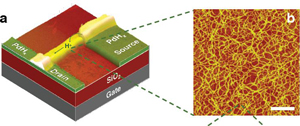DNA-based electronics are discussed in the context of a Dec. 14, 2015 news item by Beth Ellison for Azonano about research into electromechanical switches at the University of California at Davis,
Researchers from the University of California, Davis (UC Davis) and the University of Washington have shown the possibility of using DNA-based electromechanical switches for nanoscale computing.
DNA is considered to be the molecule of life, and researchers have shown considerable interest in utilizing DNA as a nanoscale material in various applications.
A Dec. 14, 2015 UC Davis news release on EurekAlert, which originated the news item, provides more detail,
In their paper published in Nature Communications, the team demonstrated that changing the structure of the DNA double helix by modifying its environment allows the conductance (the ease with which an electric current passes) to be reversibly controlled. This ability to structurally modulate the charge transport properties may enable the design of unique nanodevices based on DNA. These devices would operate using a completely different paradigm than today’s conventional electronics.
“As electronics get smaller they are becoming more difficult and expensive to manufacture, but DNA-based devices could be designed from the bottom-up using directed self-assembly techniques such as ‘DNA origami’,” said Josh Hihath, assistant professor of electrical and computer engineering at UC Davis and senior author on the paper. DNA origami is the folding of DNA to create two- and three-dimensional shapes at the nanoscale level.
“Considerable progress has been made in understanding DNA’s mechanical, structural, and self-assembly properties and the use of these properties to design structures at the nanoscale. The electrical properties, however, have generally been difficult to control,” said Hihath.
New Twist on DNA? Possible Paradigms for Computing
In addition to potential advantages in fabrication at the nanoscale level, such DNA-based devices may also improve the energy efficiency of electronic circuits. The size of devices has been significantly reduced over the last 40 years, but as the size has decreased, the power density on-chip has increased. Scientists and engineers have been exploring novel solutions to improve the efficiency.
“There’s no reason that computation must be done with traditional transistors. Early computers were fully mechanical and later worked on relays and vacuum tubes,” said Hihath. “Moving to an electromechanical platform may eventually allow us to improve the energy efficiency of electronic devices at the nanoscale.”
This work demonstrates that DNA is capable of operating as an electromechanical switch and could lead to new paradigms for computing.
To develop DNA into a reversible switch, the scientists focused on switching between two stable conformations of DNA, known as the A-form and the B-form. In DNA, the B-form is the conventional DNA duplex that is commonly associated with these molecules. The A-form is a more compact version with different spacing and tilting between the base pairs. Exposure to ethanol forces the DNA into the A-form conformation resulting in an increased conductance. Similarly, by removing the ethanol, the DNA can switch back to the B-form and return to its original reduced conductance value.
One Step Toward Molecular Computing
In order to develop this finding into a technologically viable platform for electronics, the authors also noted that there is still a great deal of work to be done. Although this discovery provides a proof-of-principle demonstration of electromechanical switching in DNA, there are generally two major hurdles yet to be overcome in the field of molecular electronics. First, billions of active molecular devices must be integrated into the same circuit as is done currently in conventional electronics. Next, scientists must be able to gate specific devices individually in such a large system.
“Eventually, the environmental gating aspect of this work will have to be replaced with a mechanical or electrical signal in order to locally address a single device,” noted Hihath.
Here’s a link to and a citation for the paper,
Conformational gating of DNA conductance by Juan Manuel Artés, Yuanhui Li, Jianqing Qi, M. P. Anantram, & Joshua Hihath. Nature Communications 6, Article number: 8870 doi:10.1038/ncomms9870 Published 09 December 2015
This paper is open access.
